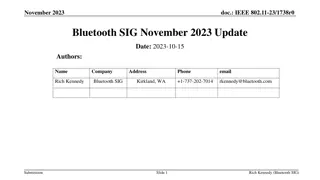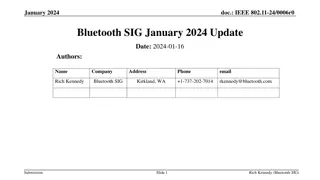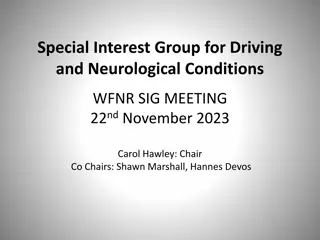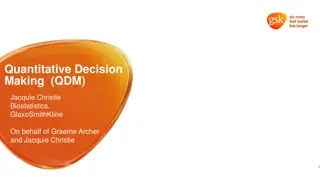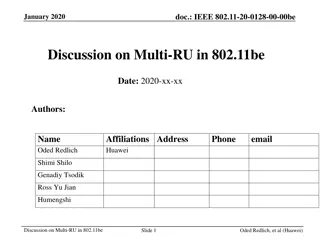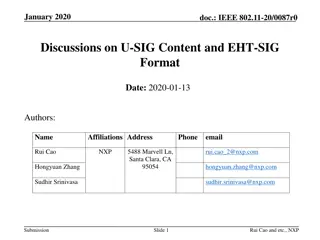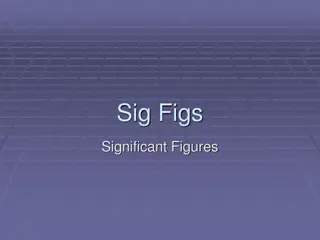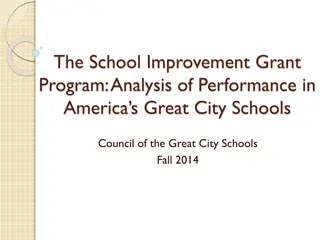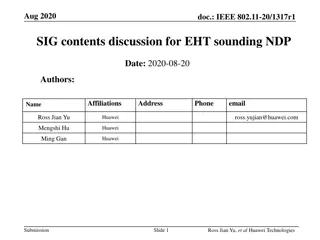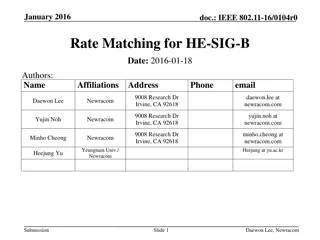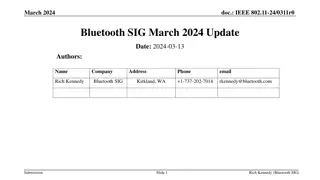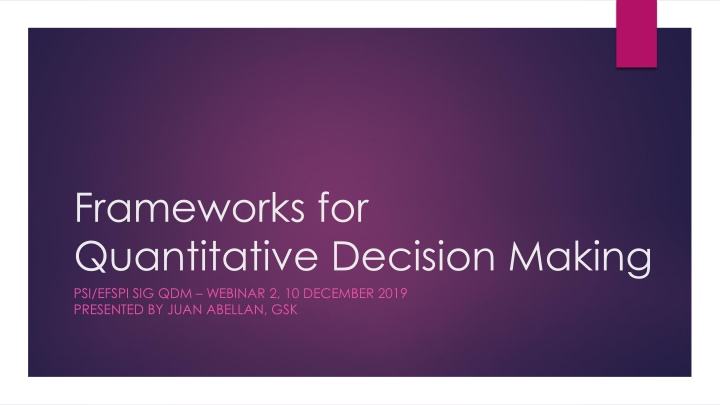
Quantitative Decision Making Frameworks for Study Results Analysis
Explore the importance of quantitative decision-making frameworks in analyzing study results for informed decision-making. Understand the significance of linking questions, design, and results to make effective decisions post-study. Avoid common pitfalls related to study success criteria and statistical hypothesis evaluation through a structured QDM approach.
Download Presentation

Please find below an Image/Link to download the presentation.
The content on the website is provided AS IS for your information and personal use only. It may not be sold, licensed, or shared on other websites without obtaining consent from the author. If you encounter any issues during the download, it is possible that the publisher has removed the file from their server.
You are allowed to download the files provided on this website for personal or commercial use, subject to the condition that they are used lawfully. All files are the property of their respective owners.
The content on the website is provided AS IS for your information and personal use only. It may not be sold, licensed, or shared on other websites without obtaining consent from the author.
E N D
Presentation Transcript
Frameworks for Quantitative Decision Making PSI/EFSPI SIG QDM WEBINAR 2, 10 DECEMBER 2019 PRESENTED BY JUAN ABELLAN, GSK
2 Making decisions after study results Scientific question(s) of interest Study design Study results Decisions Toxicity? Proof of mechanism? Proof of concept? Dose-response? Rigorous and ethical scientific experiment Informing around quantities of interest and associated uncertainty Continue development? (GO / No-GO) There should be a clear link between question(s) design results decisions Substantial effort put into design (inclusion/exclusion criteria, endpoints, assumptions for sample size, ) But less attention paid to mapping results to decisions PSI Webinar - Quantitative Decision-Making PSI/EFSPI SIG QDM, 10 DECEMBER 2019
3 Why a QDM framework? We all have probably come across examples like these in study protocols: The sample size has been chosen based on feasibility The study team does not agree with quantitatively defining what constitutes study success due to the exploratory nature of the study The risk around having specific criteria (e.g., numbers) is that if we do not achieve these it could prevent progression This is an exploratory study, no formal evaluation of statistical hypotheses will be conducted Even if there are no significant differences in [primary endpoint] between the two treatment groups, there may be other assessments that may detect difference between the treatment groups PSI Webinar - Quantitative Decision-Making PSI/EFSPI SIG QDM, 10 DECEMBER 2019
4 Why a QDM framework? Being vague around how we will assess evidence at the end of the study and how we will proceed afterwards will increase the chances of making wrong decisions For example, we may end up retrofitting theories that could explain why the observed results are not what we expected and use that to justify a GO decision only to fail at a later stage Scientific judgement is key to link results to decisions and we should make the most of it. But post-hoc may be prone to biases Thinking ahead of the study what a successful outcome means is also good science A quantitative decision-making framework is a scaffold set before the study takes place where we establish how decisions will be made based on study outcomes PSI Webinar - Quantitative Decision-Making PSI/EFSPI SIG QDM, 10 DECEMBER 2019
5 A familiar decision framework In the past, we have relied too much on statistical significance for decision making Study results Decisions If ? < 0.05 GO (meaning of GO is context-dependent) If ? 0.05 No GO (in practice often STOP) Decision criteria based on p-values are not good because a p-value on its own says little around the size of the treatment effect and associated uncertainty (see ASA statement on p-values, The American Statistician, 2016 70:2, 129:133) PSI Webinar - Quantitative Decision-Making PSI/EFSPI SIG QDM, 10 DECEMBER 2019
6 Basis for better QDM frameworks Why not setting decision criteria based on size of the treatment effect and our confidence on that size being large enough? The target product profile (TPP) of a new compound contains information around minimum size of treatment effect for the new medicine to add value for patients Notation: = expected value of treatment effect We could use that minimum value (MV) for in the TPP to set a decision criterion of the form: If we are confident enough that > ??, then GO; otherwise STOP We assess if we are confident enough through quantification of uncertainty, e.g.: GO if after study Pr > ?? ???? > 0.8. Otherwise STOP Another possible framework that includes strong evidence to GO or to STOP would look like this: GO if after study Pr > ?? ???? > 0.8 STOP if after the study Pr > ?? ???? < 0.2 [equivalent to Pr < ?? ???? > 0.8] CONSIDER otherwise (i.e. if evidence of > ?? is neither strong nor weak) PSI Webinar - Quantitative Decision-Making PSI/EFSPI SIG QDM, 10 DECEMBER 2019
7 Graphically The stronger the evidence that > ??, the more convinced we are to GO The stronger the evidence that < ??, the more convinced we are to STOP MV Treatment effect ( ) PSI Webinar - Quantitative Decision-Making PSI/EFSPI SIG QDM, 10 DECEMBER 2019
8 More elaborated QDM frameworks In addition to the MV, we may also consider other relevant sizes for the treatment effect to construct the QDM framework For example, a target value (TV) for the new drug to have an increased value for patients We could then use the MV for the GO criterion and the TV for the No-GO/STOP one, e.g. (Frewer et al; Pharmaceut. Statist. 2016, 15:255 263) GO if we are X% confident that > ?? STOP if we are Y% confident that < ?? CONSIDER otherwise (i.e. if neither GO nor STOP and perhaps also if both GO and STOP) PSI Webinar - Quantitative Decision-Making PSI/EFSPI SIG QDM, 10 DECEMBER 2019
9 Graphically The stronger the evidence that > ??, the more convinced we are we want to GO The stronger the evidence that < ??, the more convinced we are we want to STOP Otherwise CONSIDER TV MV Treatment effect ( ) PSI Webinar - Quantitative Decision-Making PSI/EFSPI SIG QDM, 10 DECEMBER 2019
10 Another option The stronger the evidence that > ??, the more convinced we are we want to at least CONSIDER The stronger the evidence that > ??, the more convinced we are we want to GO Otherwise STOP TV MV Treatment effect ( ) PSI Webinar - Quantitative Decision-Making PSI/EFSPI SIG QDM, 10 DECEMBER 2019
11 Conditional operating characteristics of a QDM framework How often a decision framework leads to good decisions or bad decisions, over a range of possible scenarios? Evaluation of OCs is crucial to determine the usefulness of a decision framework Basically, we simulate clinical trial datasets over a range of true values of , and count the proportion of times such datasets would trigger any of the possible decisions in the framework (e.g. GO/STOP or GO/STOP/CONSIDER) Communicating OCs OCs are best summarised through graphics Criteria in QDM frameworks also map to observed results. This can be used to translate GO/STOP criteria into a more intuitive scale: the estimated value of the treatment effect PSI Webinar - Quantitative Decision-Making PSI/EFSPI SIG QDM, 10 DECEMBER 2019
12 Conditional OCs Decision criteria Pr(STOP) If Pr > MV ???? > 80% GO If Pr < ?? ???? > 90% STOP Pr(CONSIDER) CONSIDER otherwise Curves represent, for a range of values Pr(GO) Probability of GO MV TV Probability of STOP PSI Webinar - Quantitative Decision-Making PSI/EFSPI SIG QDM, 10 DECEMBER 2019
13 Mapping decision rules to results 60% credibility interval 80% credibility interval PSI Webinar - Quantitative Decision-Making PSI/EFSPI SIG QDM, 10 DECEMBER 2019
14 Unconditional operating characteristics of a QDM framework Understanding the probabilities of GO/STOP/CONSIDER conditional on is useful But are all values for equally likely? Existing data/information around the drug and disease can be used to derive/elicit a prior distribution for the treatment effect Such a prior can be used to obtain the unconditional probabilities of GO/STOP/CONSIDER Pr(GO) is sometimes referred to as probability of success, or assurance Both conditional and unconditional probabilities inform about the usefulness of a QDM framework as well as other aspects of study design (e.g. sample size) PSI Webinar - Quantitative Decision-Making PSI/EFSPI SIG QDM, 10 DECEMBER 2019
15 Probability of GO/CONSIDER/STOP True effect Probability of making each decision for a given true effect Go (%) (%) 50% 40% 10% 40% 0% 0% 75% 16% Consider Stop (%) 10% 50% 100% 9% TV = 1.5 MV = 1.25 No effect = 0 Assurance PSI Webinar - Quantitative Decision-Making PSI/EFSPI SIG QDM, 10 DECEMBER 2019
16 QDM framework with two endpoints For each of the two endpoints, we set GO/STOP/CONSIDER criteria Study team should decide how each of 9 outcomes will map to the possible 3 decisions PSI Webinar - Quantitative Decision-Making PSI/EFSPI SIG QDM, 10 DECEMBER 2019
17 Discussion Pre-specification of a QDM framework mapping study outcomes to GO/STOP/CONSIDER decisions is a driver for better decision making Time/effort currently spent discussing results post-hoc and deciding what-next would probably be more useful if invested in establishing a QDM framework ahead of the study QDM frameworks with decision criteria based on size of treatment effect are sensible. For confirmatory studies however, the decision criterion will typically be a significant p-value Understanding the operating characteristics of a QDM framework (both conditional and unconditional if a prior distribution is available) will help optimising the study design The regular use of QDM frameworks in an organisation as part of a study design Should reduce cycle times: once results are available, the framework is applied and decisions are executed Enable standardisation of operating characteristics of a study design for discussion at review/governance boards QDM frameworks combined with prior information enable predictions for future studies in the development programme PSI Webinar - Quantitative Decision-Making PSI/EFSPI SIG QDM, 10 DECEMBER 2019



